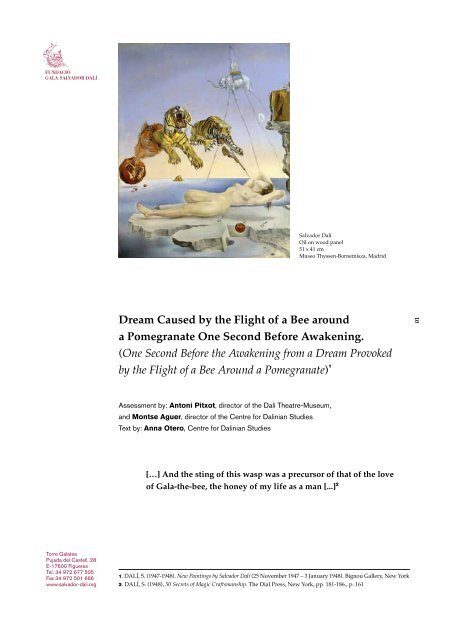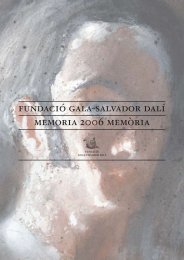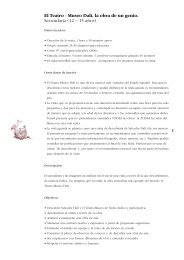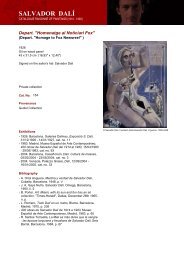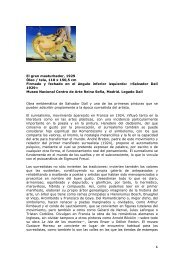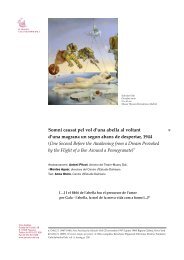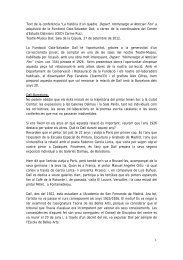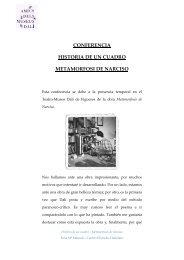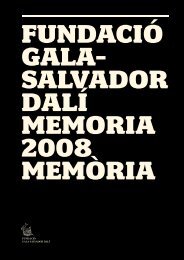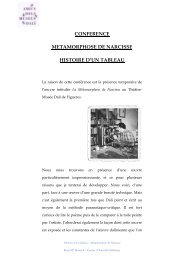Dream Caused by the Flight of a Bee around a Pomegranate One ...
Dream Caused by the Flight of a Bee around a Pomegranate One ...
Dream Caused by the Flight of a Bee around a Pomegranate One ...
- No tags were found...
Create successful ePaper yourself
Turn your PDF publications into a flip-book with our unique Google optimized e-Paper software.
Salvador DalíOil on wood panel51 x 41 cmMuseo Thyssen-Bornemisza, Madrid<strong>Dream</strong> <strong>Caused</strong> <strong>by</strong> <strong>the</strong> <strong>Flight</strong> <strong>of</strong> a <strong>Bee</strong> <strong>around</strong>a <strong>Pomegranate</strong> <strong>One</strong> Second Before Awakening.(<strong>One</strong> Second Before <strong>the</strong> Awakening from a <strong>Dream</strong> Provoked01<strong>by</strong> <strong>the</strong> <strong>Flight</strong> <strong>of</strong> a <strong>Bee</strong> Around a <strong>Pomegranate</strong>) 1Assessment <strong>by</strong>: Antoni Pitxot, director <strong>of</strong> <strong>the</strong> Dalí Theatre-Museum,and Montse Aguer, director <strong>of</strong> <strong>the</strong> Centre for Dalinian StudiesText <strong>by</strong>: Anna Otero, Centre for Dalinian Studies[…] And <strong>the</strong> sting <strong>of</strong> this wasp was a precursor <strong>of</strong> that <strong>of</strong> <strong>the</strong> love<strong>of</strong> Gala-<strong>the</strong>-bee, <strong>the</strong> honey <strong>of</strong> my life as a man [...] 2Torre GalateaPujada del Castell, 28E-17600 FigueresTel. 34 972 677 505Fax 34 972 501 666www.salvador-dali.org1. DALÍ, S. (1947-1948). New Paintings <strong>by</strong> Salvador Dalí (25 November 1947 – 3 January 1948). Bignou Gallery, New York2. DALÍ, S. (1948), 50 Secrets <strong>of</strong> Magic Craftsmanship. The Dial Press, New York, pp. 181-186., p. 161
INTRODUCTIONThanks to <strong>the</strong> Fundació Gala-Salvador Dalí’s policy <strong>of</strong> active cooperation with o<strong>the</strong>r institutionswhose collections include works <strong>by</strong> Salvador Dalí, visitors to <strong>the</strong> Dalí Theatre-Museum inFigueres have recently been able to see a number <strong>of</strong> <strong>the</strong> artist’s major pictures on temporaryloan, such as Metamorphosis <strong>of</strong> Narcissus and The Persistence <strong>of</strong> Memory. In 2010 we are pleased topresent <strong>the</strong> oil painting <strong>Dream</strong> <strong>Caused</strong> <strong>by</strong> <strong>the</strong> <strong>Flight</strong> <strong>of</strong> a <strong>Bee</strong> <strong>around</strong> a <strong>Pomegranate</strong> <strong>One</strong> Second BeforeAwakening, from 1944, generously loaned <strong>by</strong> <strong>the</strong> Thyssen-Bornemisza Museum in Madrid. Thework will be on show at <strong>the</strong> Dalí Theatre-Museum in Figueres, from 9 February to 2 May 2010.For <strong>the</strong> occasion, <strong>the</strong> Fundació Gala-Salvador Dalí has prepared a dossier and a number <strong>of</strong>informative materials in order to present and analyse a significant picture from Dalí’s oeuvre.1. WORKDescriptionWhen Gala described to Dalí <strong>the</strong> strange images she had seen in a dream that was somehowrelated to <strong>the</strong> flight <strong>of</strong> a bee <strong>around</strong> a pomegranate, <strong>the</strong> artist lost no time in painting <strong>Dream</strong><strong>Caused</strong> <strong>by</strong> <strong>the</strong> <strong>Flight</strong> <strong>of</strong> a <strong>Bee</strong> <strong>around</strong> a <strong>Pomegranate</strong> <strong>One</strong> Second Before Awakening, <strong>of</strong> 1944. 3 Thesetting for <strong>the</strong> picture is once again a landscape <strong>of</strong> Portlligat, which Gala shares with twopomegranates, a large scorpionfish, two tigers, a rifle with a bayonet, a bee and an elephant withlong, insect-like legs. All <strong>of</strong> <strong>the</strong>se elements, presented in a manner that could be regarded as acinematic sequence, are part <strong>of</strong> <strong>the</strong> dream <strong>of</strong> a voluptuous reclining Gala who seems obliviousto <strong>the</strong> strange events going on <strong>around</strong> her. The reading <strong>of</strong> <strong>the</strong> painting, as its title makes clear,starts with <strong>the</strong> bee hovering over <strong>the</strong> small pomegranate in <strong>the</strong> foreground. This pomegranate02is also <strong>the</strong> origin and source <strong>of</strong> Gala’s dream, depicted on <strong>the</strong> left side <strong>of</strong> <strong>the</strong> picture.Looking a little more closely, we see that none <strong>of</strong> <strong>the</strong> objects that appear in <strong>the</strong> picture istouching any <strong>of</strong> <strong>the</strong> o<strong>the</strong>rs: everything floats, everything hangs suspended. The dream-imageis <strong>the</strong> snapshot <strong>of</strong> a precise moment, frozen and perfectly painted <strong>by</strong> hand.The Context <strong>of</strong> <strong>the</strong> WorkDalí painted <strong>Dream</strong> <strong>Caused</strong> <strong>by</strong> <strong>the</strong> <strong>Flight</strong> <strong>of</strong> a <strong>Bee</strong>… at a time <strong>of</strong> historical impasse and a stylisticcrossroads: World War II was drawing to an end and a distinctively American art was emerging.The year was 1944: Dalí’s creativity was burgeoning, coinciding with <strong>the</strong> mid point in his stayin America (1940-1948). When Dalí arrived in <strong>the</strong> United States in 1940 he declared that hisintention was to become rich and famous. During his stay in <strong>the</strong> New World, Dalí consolidatedhis persona, involved himself in various projects (sets for <strong>the</strong> <strong>the</strong>atre, ballet and opera, filmscripts, illustrations for books, designs for jewellery and clo<strong>the</strong>s, photographic projects…)and socialized with rich and influential people, ensuring his social standing.3. TAYLOR, M. (2004). “<strong>Dream</strong> <strong>Caused</strong> <strong>by</strong> <strong>the</strong> <strong>Flight</strong> <strong>of</strong> a <strong>Bee</strong> <strong>around</strong> a <strong>Pomegranate</strong>, <strong>One</strong> Second beforeAwakening” In: Dalí, Bompiani, Milan, p. 334
Painting for <strong>the</strong> ballet Sentimental ColloquyPoster advertising <strong>the</strong> book Hidden FacesThe year 1944 was a very productive one for Dalí. He designed advertising images for <strong>the</strong>stocking manufacturer Bryans, for perfume, lipstick and o<strong>the</strong>r products for Elsa Schiaparelli,and for McCurrach ties; he contributed articles and illustrations to a number <strong>of</strong> magazines, andin June published his only novel, Hidden Faces. At <strong>the</strong> end <strong>of</strong> <strong>the</strong> summer he signed <strong>the</strong> contractthat resulted in his creating <strong>the</strong> dream sequence for Alfred Hitchcock’s film Spellbound, whichpremiered in 1945. During <strong>the</strong> last three months <strong>of</strong> 1944 he designed <strong>the</strong> sets for <strong>the</strong> stage playSentimental Colloquy and created <strong>the</strong> libretto, <strong>the</strong> costumes and <strong>the</strong> sets for <strong>the</strong> ballet Mad Tristan.2. SALVADOR DALÍThe Historical Context in Europe and <strong>the</strong> United States03With <strong>the</strong> outbreak <strong>of</strong> World War II, <strong>the</strong> art scene in both Europe and America underwent asudden drastic change, and among <strong>the</strong> artists who fled a Europe at war many sought refuge in<strong>the</strong> United States. This migration left Europe relatively bereft <strong>of</strong> artists while America gainedsignificantly in artistic importance. The new continent’s absorption <strong>of</strong> transatlantic émigréintellectuals coincided with <strong>the</strong> advent <strong>of</strong> a specifically American form <strong>of</strong> modern art: AbstractExpressionism. Dalí painted <strong>Dream</strong> <strong>Caused</strong> <strong>by</strong> <strong>the</strong> <strong>Flight</strong> <strong>of</strong> a <strong>Bee</strong>… at a time when <strong>the</strong> Surrealism<strong>of</strong> <strong>the</strong> exiled coexisted with <strong>the</strong> newly emerging Abstract Expressionism. This was a period <strong>of</strong>great upheaval in art, a moment <strong>of</strong> syn<strong>the</strong>sis between abstraction and surrealism, marked <strong>by</strong><strong>the</strong> emergence <strong>of</strong> what would come to be known as <strong>the</strong> New York School, whose prominentfigures included Mark Rothko, Jackson Pollock, William Baziotes and Robert Mo<strong>the</strong>rwell. Dalítook no part in this pictorial transition at <strong>the</strong> artistic level, in <strong>the</strong> sense that he was not a member<strong>of</strong> any movement and instead remained faithful to his own style. There was to be no stylisticbreak in his work, no move towards Abstract Expressionism; nor did he form strong personalties with any <strong>of</strong> <strong>the</strong> émigré artists. Maintaining his provocative, rebellious spirit, Dalí baptisedhis painting anew, calling for a return to classicism and turning to photographic realism. Aswe can see in <strong>Dream</strong> <strong>Caused</strong> <strong>by</strong> <strong>the</strong> <strong>Flight</strong> <strong>of</strong> a <strong>Bee</strong>… this was bound up with an evident pictorialpreciosity, and indeed Dalí described painting as ‘“photography” done <strong>by</strong> hand and in colours<strong>of</strong> <strong>the</strong> “concrete irrationality” and <strong>of</strong> <strong>the</strong> imaginative world in general’. 44. DALÍ, S. (1934), ‘The Latest Modes <strong>of</strong> Intellectual Stimulation for <strong>the</strong> Summer <strong>of</strong> 1934’. In: Finkelstein, H.The Collected Writings <strong>of</strong> Salvador Dalí, Cambridge University Press, 1998, p. 254
In <strong>the</strong> midst <strong>of</strong> this turmoil <strong>of</strong> tendencies and changes, Dalí engaged in a dialogue with ‘<strong>the</strong>American way <strong>of</strong> life’, making use <strong>of</strong> <strong>the</strong> techniques <strong>of</strong> promotion and advertising that hadended up defining so much <strong>of</strong> American culture. Dalí took advantage <strong>of</strong> his stay in Americato put <strong>the</strong> finishing touches to <strong>the</strong> persona <strong>of</strong> Salvador Dalí that was to gain him universalrecognition.Artistic InfluencesAt an opening in <strong>the</strong> Julien Levy Gallery in New York in April 1941, three years before hepainted <strong>Dream</strong> <strong>Caused</strong> <strong>by</strong> <strong>the</strong> <strong>Flight</strong> <strong>of</strong> a <strong>Bee</strong>…, Dalí announced that his painting was to bringabout a return to ‘<strong>the</strong> classical era’. Only a few months after his arrival in <strong>the</strong> United States,Dalí was looking for inspiration and a new pictorial model in <strong>the</strong> proportion and harmony <strong>of</strong><strong>the</strong> Italian Renaissance, marking not so much a radical stylistic break as a departure from <strong>the</strong>Surrealist fold:‘My surrealist glory was worthless. I must incorporate surrealism in tradition. Myimagination must become classic again. I had before me a work to accomplish forwhich <strong>the</strong> rest <strong>of</strong> my life would not suffice. Gala made me believe in this mission.’ 5Visually, we find not a break in <strong>the</strong> style <strong>of</strong> his work but a reutilizing and exploiting <strong>of</strong> certainelements, <strong>of</strong> which <strong>the</strong> landscape is <strong>the</strong> most striking example. Associations with <strong>the</strong> world<strong>of</strong> mass culture are manifestly present in Dalí’s paintings <strong>of</strong> <strong>the</strong> nineteen forties. In everydaythings, used and demanded <strong>by</strong> <strong>the</strong> public at large, he found a rich source <strong>of</strong> inspiration. Hehad previously depicted a Coca-Cola bottle in <strong>the</strong> 1943 painting The Poetry <strong>of</strong> America, severalyears in advance <strong>of</strong> <strong>the</strong> iconography <strong>of</strong> Pop Art, and <strong>the</strong> tigers in <strong>Dream</strong> <strong>Caused</strong> <strong>by</strong> <strong>the</strong> <strong>Flight</strong> <strong>of</strong> a<strong>Bee</strong>… were taken from <strong>the</strong> posters advertising <strong>the</strong> popular Ringling Bros. and Barnum & BaileyCircus. These borrowings exemplify <strong>the</strong> working method <strong>of</strong> a great artist-observer, filteringand absorbing <strong>the</strong> world <strong>around</strong> him and painting his pictures as if <strong>the</strong>y were hand-colouredphotographs, effectively assimilating painting to <strong>the</strong> photographic image.04Ringling Barnun Bailey Circus posterDalí took advantage <strong>of</strong> this mediatic moment to seize <strong>the</strong> attention <strong>of</strong> <strong>the</strong> media whileworking with and exploring <strong>the</strong> potential <strong>of</strong> supports o<strong>the</strong>r than <strong>the</strong> traditional canvas. Themultitude <strong>of</strong> options Dalí tested out — new supports, <strong>the</strong> artistic function <strong>of</strong> popular imagery,<strong>the</strong> championing <strong>of</strong> an anachronistic classicism… — looked forward to many aspects <strong>of</strong>contemporary art: certain Dalinian connotations can be seen in <strong>the</strong> work <strong>of</strong> artists such as AndyWarhol, Roy Lichtenstein and Jeff Koons.5. DALÍ, S. (1942). The Secret Life <strong>of</strong> Salvador Dalí. The Dial Press, New Press, p. 350
3. INTERPRETATIONThe LandscapeThe landscape in <strong>Dream</strong> <strong>Caused</strong> <strong>by</strong> <strong>the</strong> <strong>Flight</strong> <strong>of</strong> a <strong>Bee</strong>… is perhaps <strong>the</strong> most recognizable elementin <strong>the</strong> picture, in that it corresponds to Dalí’s immediate and omnipresent surroundings. Forall <strong>the</strong>ir realism, <strong>the</strong> landscapes that Dalí painted in <strong>the</strong> nineteen forties are products <strong>of</strong> <strong>the</strong>imagination, <strong>of</strong> dreams and memories: <strong>the</strong> artist lived in <strong>the</strong> United States continuously for aperiod <strong>of</strong> eight years (1940-1948), a long way from <strong>the</strong> Empordà.The figure <strong>of</strong> Gala lies stretched out on a rocky platform that floats above <strong>the</strong> sea. The cliff on<strong>the</strong> right is reminiscent <strong>of</strong> those Dalí painted during <strong>the</strong> thirties and, indeed, continued to paint.A few olive branches adorning <strong>the</strong> summit <strong>of</strong> <strong>the</strong> cliff are <strong>the</strong> only vegetation on <strong>the</strong> painting.The blue <strong>of</strong> <strong>the</strong> sea and <strong>the</strong> sky is divided <strong>by</strong> <strong>the</strong> first light <strong>of</strong> day, coinciding with <strong>the</strong> moment<strong>of</strong> ‘one second before awakening’; <strong>the</strong> time is dawn and <strong>the</strong> moon still lingers in <strong>the</strong> sky.In many <strong>of</strong> <strong>the</strong> pictures from Dalí’s American period (1940-1948) <strong>the</strong> landscape takes ona predominant presence. The close personal relationship that Dalí establishes with <strong>the</strong>Mediterranean setting can be seen as an extension <strong>of</strong> himself; <strong>the</strong> landscape <strong>of</strong> Cadaqués /Portlligat / Cap de Creus and Dalí are inseparable. In his writings, Dalí acknowledged <strong>the</strong>primacy <strong>of</strong> <strong>the</strong> landscape in his art:‘[…] I need only to close my eyes in order to recapture landscapes and scenes intact,but at <strong>the</strong> time I established <strong>the</strong> strangest kind <strong>of</strong> dialogue with myself. Everyrock, every promontory <strong>of</strong> Cape Creus is in permanent metamorphosis. Each is asuggestion that prompts spontaneous visualization <strong>of</strong> an eagle, a camel, a rooster, alion, a woman – but if you approach from <strong>the</strong> sea, <strong>the</strong> nearer you get, <strong>the</strong> more <strong>the</strong>symbolism develops and changes. It is a continual simulacrum. The bird becomesa wild animal and <strong>the</strong>n a barnyard fowl. Like living in a constant mirage… and yet,when we land, <strong>the</strong> granite beneath our feet is hard, compact, clear, implacable – afterhaving double-dealt us so constantly.’ 605The <strong>Pomegranate</strong>Gala’s dream, which is ‘caused <strong>by</strong> <strong>the</strong> flight <strong>of</strong> a bee <strong>around</strong> a pomegranate’, commences with<strong>the</strong> broken-open pomegranate, two seeds <strong>of</strong> which are falling into <strong>the</strong> sea and will become <strong>the</strong>pomegranate trees that Gala will plant next to <strong>the</strong> house at Portlligat. The pomegranate is an<strong>Pomegranate</strong> <strong>of</strong> PortlligatJewel The <strong>Pomegranate</strong> Heart made <strong>of</strong> gold, rubies and diamonds6. DALÍ, S. (1976). The Unspeakable Confessions <strong>of</strong> Salvador Dalí. William Morrow and Company, Inc., new York, p. 129
autumn fruit with a very ancient tradition in <strong>the</strong> Mediterranean: in <strong>the</strong> Christian religion itsymbolizes love, resurrection, eternal life and fertility, and it figures prominently in Greek ando<strong>the</strong>r mythologies. It is a fruit <strong>of</strong> evil sweetness with a variety <strong>of</strong> meanings and associations,and is both <strong>the</strong> origin and <strong>the</strong> cause <strong>of</strong> what is happening in <strong>the</strong> picture.A scorpionfish has emerged from <strong>the</strong> heart-shaped opening in <strong>the</strong> skin <strong>of</strong> fruit. In 1949, whenDalí turned to designing jewellery, he took <strong>the</strong> heart-like form <strong>of</strong> an opened pomegranate as <strong>the</strong>basis for a ‘pomegranate heart’ <strong>of</strong> gold, rubies and diamonds.The ScorpionfishThe fish being expelled from <strong>the</strong> pomegranate is a scorpionfish, <strong>of</strong> a species found in <strong>the</strong>Mediterranean. The scorpionfish habitually remains motionless among <strong>the</strong> rocks during <strong>the</strong>day, and feeds at night. The mimicry <strong>of</strong> its colouration makes it difficult to spot, but despitethis invisibility <strong>the</strong> large-eyed scorpionfish takes in everything that goes on <strong>around</strong> it. Thescorpionfish raises it poisonous dorsal fin when it senses danger, as we see it doing here, andhas a very large mouth with which to swallow its prey. The scorpionfish is a predator whoseapparent stillness deceives its victims, preventing <strong>the</strong>m from reacting in time to its attack. Wesee Dalí’s aggressive scorpionfish in <strong>the</strong> act <strong>of</strong> swallowing a tiger, which in turn is expelling asecond tiger from its mouth, as if it were an echo <strong>of</strong> itself.The TigersIn <strong>the</strong> central part <strong>of</strong> <strong>the</strong> dream, two snarling tigers spring at Gala. These animals remain verysimilar to <strong>the</strong> tigers on <strong>the</strong> posters <strong>of</strong> <strong>the</strong> Ringling Bros. and Barnum & Bailey Circus, <strong>the</strong> biggestAmerica. If we bear in mind that <strong>the</strong> merged circus already had been performing up and down<strong>the</strong> country for many years when Dalí arrives in <strong>the</strong> United States in 1940, it is more than likelythat he would have seen this image on posters announcing forthcoming shows. In this respectDalí draws on <strong>the</strong> popular imagery <strong>of</strong> <strong>the</strong> circus to awaken Gala from her sleep. However, it isnot <strong>the</strong> roar <strong>of</strong> <strong>the</strong> tiger but <strong>the</strong> rifle with its bayonet, a simulacrum <strong>of</strong> <strong>the</strong> bee’s sting, that willrouse her from her slumber.06The ElephantThe <strong>the</strong>me <strong>of</strong> <strong>the</strong> dream is also apparent in <strong>the</strong> figure <strong>of</strong> <strong>the</strong> elephant with greatly elongatedlegs, an animal that Dalí incorporated into his iconography in <strong>the</strong> early forties. The aes<strong>the</strong>ticinspiration for <strong>the</strong> elephant-cum-insect with an obelisk on its back was <strong>the</strong> Pulcino della Minerva,a sculpture <strong>of</strong> an elephant designed <strong>by</strong> Bernini in <strong>the</strong> seventeenth century, which standsoutside <strong>the</strong> basilica <strong>of</strong> Santa Maria sopra Minerva in Rome. Bernini’s Pulcino della Minerva isa recreation <strong>of</strong> an elephant bearing a 6 th -century BCE Egyptian obelisk on its back. Curiously,<strong>the</strong> Bernini sculpture has similarities with <strong>the</strong> woodcut <strong>of</strong> an elephant in <strong>the</strong> Renaissance novelHypnerotomachia Poliphili (1499). <strong>Dream</strong>s play a very important part in <strong>the</strong> novel, and <strong>the</strong> image<strong>of</strong> <strong>the</strong> elephant bearing <strong>the</strong> obelisk we see in Dalí’s painting effectively bestrides <strong>the</strong> dream.Dalí thus takes <strong>the</strong> Bernini elephant, which derives in its turn from a Renaissance dream, andDalífies it, stretching its legs. In a sense, with this elephant Dalí is inviting us to share in one <strong>of</strong><strong>the</strong> many metamorphoses that occur in his works.
‘[…] flying about like a bee, which is also one <strong>of</strong> <strong>the</strong> names which I have given her,for like a bee she brings me all <strong>the</strong> oils, all <strong>the</strong> media, and it is thus that I find <strong>the</strong>pentagonal hive <strong>of</strong> my studio filled with all <strong>the</strong> pollens which <strong>the</strong> painter, at everymoment <strong>of</strong> <strong>the</strong> day, needs to be able to spin <strong>the</strong> integral honey <strong>of</strong> his work.’ 7<strong>Dream</strong>sThe precise moment painted <strong>by</strong> Dalí in <strong>Dream</strong> <strong>Caused</strong> <strong>by</strong> <strong>the</strong> <strong>Flight</strong> <strong>of</strong> a <strong>Bee</strong>… is exactly onesecond before Gala awakes to find herself attacked <strong>by</strong> a dream in <strong>the</strong> form <strong>of</strong> a rifle witha bayonet and two tigers, one being swallowed <strong>by</strong> a scorpionfish which in turn has beenexpelled from an open pomegranate. With this succession <strong>of</strong> dreamlike actions Dalí lets us seethat Surrealism and Freudian psychoanalysis are still present in <strong>the</strong> iconography <strong>of</strong> his work:<strong>the</strong> free association <strong>of</strong> images leads <strong>the</strong> unconscious to <strong>the</strong> conscious mind. In looking at <strong>the</strong>painting we involuntarily become interpreters <strong>of</strong> dreams. With <strong>Dream</strong> <strong>Caused</strong> <strong>by</strong> <strong>the</strong> <strong>Flight</strong> <strong>of</strong> a<strong>Bee</strong>… Dalí wants to share with <strong>the</strong> spectator-interpreter a moment from Gala’s subconscious asthis has been interpreted <strong>by</strong> him with his brushes.08<strong>Dream</strong> <strong>Caused</strong> <strong>by</strong> <strong>the</strong> <strong>Flight</strong> <strong>of</strong> a <strong>Bee</strong>…,Dalí had always been fascinated <strong>by</strong> dreams, as <strong>the</strong> following entry in his adolescent diary attests:‘It is cloudy today like yesterday. But I feel fine and I get up. I had a delightfulnight. <strong>Dream</strong>s are something I love. I usually pass <strong>the</strong> nights in extraordinaryand delightful dreams, which I do not recount because all <strong>the</strong> details fly from mymemory.’ 8Long after <strong>the</strong> most Surrealist years (<strong>the</strong> 1930s), dreams continue to be a recurrent <strong>the</strong>me inthroughout Dalí’s career. Also in 1944, <strong>the</strong> year he painted <strong>Dream</strong> <strong>Caused</strong> <strong>by</strong> <strong>the</strong> <strong>Flight</strong> <strong>of</strong> a <strong>Bee</strong>…,he was invited to design <strong>the</strong> dream scene for Alfred Hitchcock’s film Spellbound. Dalí told <strong>the</strong>press at <strong>the</strong> time that he mostly dreamt in shades <strong>of</strong> grey, but that a few times each month,7. DALÍ, S. (1948), 50 Secrets <strong>of</strong> Magic Craftsmanship. The Dial Press, New York, pp. 181-1868. DALÍ, S. (2003), ‘Un Diari 1919-1920: les meves impressions i records íntims’. In: Obra completa, Barcelona;[Figueres]: Ediciones Destino; Fundació Gala-Salvador Dalí, vol. 1, Escrits autobiogràfics, p. 196
although this was not a good sign, he dreamt in colour. And it was as a specialist in dreams thatLife magazine commissioned Dalí to write a piece about a nightmare. In ‘Nightmare Journey’ hetold <strong>the</strong> story <strong>of</strong> <strong>the</strong> train journey he made from New York to San Francisco, during which hewas assailed <strong>by</strong> fears and anxieties about confronting <strong>the</strong> practical aspects <strong>of</strong> everyday life. Dalístarts his account with a confession:‘At night I always dream <strong>of</strong> extremely agreeable things, and it is precisely when Iam perfectly wide-awake, in broad daylight and in contact with practical life, thatmy most hallucinatory nightmares have always occurred.’ 9099. DALÍ, S. ‘Nightmare Journey’, Life, 6 March 1944.
APPENDICEWorks Produced <strong>by</strong> Dalí in 1944February:Advertisement, ‘John Frederics Golden Arrow Toiletries’, in Vogue, 01/02/1944.Article, ‘<strong>Dream</strong> vs. Reality’, in Vogue, with drawings <strong>by</strong> Dalí advertising dresses <strong>by</strong> HenriBendel, Garfinckel’s and L. S. Ayres, 15/02/1944.March:Advertisement, ‘The 4 Oils <strong>of</strong> Schiaparelli Shocking Radiance’, in Harper’s Bazaar, 03/1944.Advertisement, ‘John Frederics Golden Arrow Toiletries’, in Harper’s Bazaar, 03/1944.Article, ‘Nightmare Journey’, <strong>by</strong> Salvador Dalí in Life, 06/03/1944.Article, ‘Uncovering Hidden Faces’, written and illustrated <strong>by</strong> Salvador Dalí in <strong>the</strong> magazineTown & Country, 03/1944.April:Design for <strong>the</strong> cover <strong>of</strong> Vogue, 01/04/1944.Advertisement, ‘John Frederics Golden Arrow Toiletries’ in Vogue, 01/04/1944.May:Advertisement, ‘Schiaparelli Red Shocking Radiance’ in Vogue, 15/05/1944.Advertisement, ‘Bryans Hosiery’ in Vogue, 15/05/1944.June:Publication <strong>of</strong> Hidden Faces, Salvador Dalí’s first and only novel, with a his own cover design.10July:Advertisement, ‘The 4 Oils <strong>of</strong> Schiaparelli Shocking Radiance’, in Harper’s Bazaar, 07/1944.August:Signing <strong>of</strong> <strong>the</strong> contract to create <strong>the</strong> dream scene in Alfred Hitchcock’s film Spellbound.September:Advertisement, Bryans Hosiery, in Vogue, 01/09/1944.Advertisement, ‘Give Ties With Personality’ <strong>of</strong> ties designed <strong>by</strong> Salvador Dalí, <strong>the</strong> TimesMagazine, 17/09/1944.Advertisement, ‘The 4 Oils <strong>of</strong> Schiaparelli Shocking Radiance’, in <strong>the</strong> magazine Art News,09/1944.October:Advertisement, ‘Men’s Ties <strong>by</strong> Salvador Dalí’, for ties designed <strong>by</strong> Salvador Dalí, in <strong>the</strong> dailyUnion Morning, 03/10/1944.Advertisement, Bryans Hosiery, in Vogue, 15/10/1944.Set designs for <strong>the</strong> ballet Sentimental Colloquy, premiered at <strong>the</strong> International Theater in NewYork, 30/10/1944.Advertisement, McCurrach Ties, for ties designed <strong>by</strong> Salvador Dalí in Esquire: The Magazine forMen, 10/1944.
November:Paints The Seven Lively Arts to a commission from Billy Rose for <strong>the</strong> Ziegfield Theater in NewYork.Advertisement, ‘A Red Heart Decorated <strong>by</strong> Dalí’, in Harper’s Bazaar, 11/1944.Designs a poster on syphilis, which is presented in an exhibition organized <strong>by</strong> Elsa Schiaparelliin <strong>the</strong> Wildestein Galleries in New York, 06/11/1944.Advertisement for Vogue in Women’s Wear, 16/11/1944.December:Set, costume and programme designs for <strong>the</strong> ballet Mad Tristan, which is premiered <strong>by</strong> <strong>the</strong> BalletInternational at <strong>the</strong> International Theater in New York, 15/12/1944.Article, ‘Crazy… Like a Fox’, <strong>by</strong> Mel Heimer, published in New York Journal American andillustrated with Salvador Dalí’s drawing ‘Hollywood’, 02.12.1944.Advertisement, Bryans Hosiery, in <strong>the</strong> magazine Art News Annual, 12/1944.Advertisement, ‘Salvador Dalí Designs Ties’, for ties designed <strong>by</strong> Salvador Dalí, in <strong>the</strong> daily TheNew York Sun, 06/12/1944.11
NOTES ON THE PRELIMINARY SKETCHES OF THE WORKIrene Civil, Conservation and Restoration Dept.<strong>of</strong> <strong>the</strong> Fundació Gala-Salvador DalíThe Dalí Foundation keeps a large number <strong>of</strong> drawings made in preparation for Dalí works,and <strong>the</strong>y constitute an important source <strong>of</strong> information about <strong>the</strong> artist’s creative process andworking method, as well as <strong>the</strong> techniques and materials he used. In <strong>the</strong> case <strong>of</strong> <strong>Dream</strong> <strong>Caused</strong> <strong>by</strong><strong>the</strong> <strong>Flight</strong> <strong>of</strong> a <strong>Bee</strong>... <strong>the</strong> Foundation has in its collections a pencil and charcoal sketch on tracingpaper <strong>of</strong> <strong>the</strong> work’s central composition, in which Dalí emphasises <strong>the</strong> crossed diagonals thatform <strong>the</strong> figures (Fig. 1). Then again, <strong>the</strong> artist makes some tenuous schematic outlines in pencil<strong>of</strong> <strong>the</strong> rocks on <strong>the</strong> right-hand side <strong>of</strong> <strong>the</strong> painting and <strong>of</strong> <strong>the</strong> figure <strong>of</strong> Gala, using a page <strong>of</strong>a book about geometry dating from 1938, Essai sur le rythme (Fig. 2). And on a sheet from adrawing pad we find <strong>the</strong> outline <strong>of</strong> Gala’s outstretched silhouette, sketched rapidly and easilyin pencil (Fig. 3). And finally <strong>the</strong>re is a more complete preliminary study <strong>of</strong> <strong>the</strong> dreaming Galafigure, a pencil drawing on Fabriano paper, which is presented at <strong>the</strong> exhibition along with <strong>the</strong>final painting itself (Fig. 4). This preparatory drawing <strong>of</strong> <strong>the</strong> main image was in all likelihood<strong>the</strong> one used as <strong>the</strong> basis <strong>the</strong> artist transferred to <strong>the</strong> wood panel.In addition to his preparatory drawings, Dalí took up again motifs from previous paintingsor designs taken from magazines and o<strong>the</strong>r media from mass culture, such as <strong>the</strong> tiger from acircus advertising poster or <strong>the</strong> elephant in a photograph illustrating a book about <strong>the</strong> animalkingdom, which Dalí traced in ink (Fig. 6). Then, when he had <strong>the</strong> image defined — whe<strong>the</strong>rfrom his preparatory drawing or from a poster photo — he had to transfer it to <strong>the</strong> final surface<strong>of</strong> <strong>the</strong> panel. Dalí explained his transfer method in his treatise on painting entitled 50 Secrets <strong>of</strong>Magic Craftsmanship; <strong>the</strong> method basically consisted in utilisation <strong>of</strong> a transparent intermediateplastic sheet for tracing out and conveying <strong>the</strong> image to <strong>the</strong> panel. Two <strong>of</strong> <strong>the</strong>se plastic sheetsare conserved at <strong>the</strong> Dalí Foundation: one with <strong>the</strong> image <strong>of</strong> <strong>the</strong> work’s central image <strong>of</strong> <strong>the</strong>tiger (Fig. 5) and <strong>the</strong> o<strong>the</strong>r with <strong>the</strong> image <strong>of</strong> <strong>the</strong> elephant (Fig. 7).12


